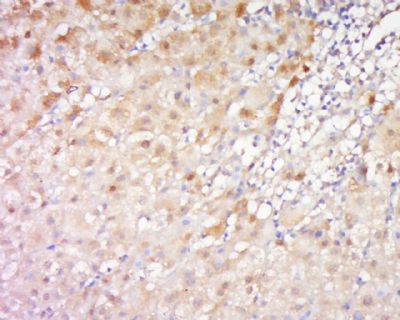FRY/C13orf14 Polyclonal Antibody
Purified Rabbit Polyclonal Antibody (Pab)
- SPECIFICATION
- CITATIONS
- PROTOCOLS
- BACKGROUND

Application
| IHC-P, IHC-F, IF, ICC, E |
|---|---|
| Primary Accession | Q5TBA9 |
| Reactivity | Rat, Dog, Bovine |
| Host | Rabbit |
| Clonality | Polyclonal |
| Calculated MW | 339 KDa |
| Physical State | Liquid |
| Immunogen | KLH conjugated synthetic peptide derived from human FRY/C13orf14 |
| Epitope Specificity | 101-200/3013 |
| Isotype | IgG |
| Purity | affinity purified by Protein A |
| Buffer | 0.01M TBS (pH7.4) with 1% BSA, 0.02% Proclin300 and 50% Glycerol. |
| SUBCELLULAR LOCATION | Cytoplasm. Cytoplasm, cytoskeleton, microtubule organizing center, centrosome. Cytoplasm, cytoskeleton, spindle pole. Note=Distributed diffusely throughout the cytoplasm in interphase. Localizes to the separating centrosomes in prophase, to the spindle poles and spindle microtubules in prometaphase to metaphase, to spindle microtubules in anaphase and to the distal sections of the midbody in cytokinesis. Colocalizes with PLK1 to separating centrosomes and spindle poles from prophase to metaphase in mitosis, but not in other stages of the cell cycle. |
| SIMILARITY | Belongs to the furry protein family. |
| SUBUNIT | When phosphorylated by CDK1, interacts with PLK1; this interaction occurs in mitotic cells, but not in interphase cells, and leads to further phosphorylation by PLK1. Interacts with AURKA. |
| Post-translational modifications | Phosphorylated by AURKA, CDK1 and PLK1. |
| Important Note | This product as supplied is intended for research use only, not for use in human, therapeutic or diagnostic applications. |
| Background Descriptions | In yeast, flies, and worms, the Dbf2-related (Ndr) kinase protein family functions in various aspects of cell polarity and morphogenesis. The Drosophila melanogaster protein, furry, is responsible for maintaining integrity of polarized cell extensions, such as epidermal hair cells, lateral extensions of the arista and the shafts of neuronal sensory bristles. Mutations in furry lead to the formation of branched arista laterals, bristles and hairs. The yeast homolog of furry, Mor2, is important for the localization of F-actin specifically at the cell ends and is required for the restriction of the growth zones. The mammalian homolog of the Drosophila furry protein is FRY, also known as C13orf14, a 3,013 amino acid protein that probably functions as a transcription factor for genes that regulate the actin cytoskeleton. The gene encoding FRY maps to chromosome 13, which comprises nearly 4% of human DNA and contains around 114 million base pairs and 400 genes. |
| Gene ID | 10129 |
|---|---|
| Other Names | Protein furry homolog, FRY, C13orf14 |
| Dilution | IHC-P=1:100-500,IHC-F=1:100-500,ICC=1:100-500,IF=1:100-500,ELISA=1:5000-10000 |
| Format | 0.01M TBS(pH7.4), 0.09% (W/V) sodium azide and 50% Glyce |
| Storage | Store at -20 ℃ for one year. Avoid repeated freeze/thaw cycles. When reconstituted in sterile pH 7.4 0.01M PBS or diluent of antibody the antibody is stable for at least two weeks at 2-4 ℃. |
| Name | FRY |
|---|---|
| Synonyms | C13orf14 |
| Function | Plays a crucial role in the structural integrity of mitotic centrosomes and in the maintenance of spindle bipolarity by promoting PLK1 activity at the spindle poles in early mitosis. May function as a scaffold promoting the interaction between AURKA and PLK1, thereby enhancing AURKA-mediated PLK1 phosphorylation. |
| Cellular Location | Cytoplasm. Cytoplasm, cytoskeleton, microtubule organizing center, centrosome. Cytoplasm, cytoskeleton, spindle pole. Note=Distributed diffusely throughout the cytoplasm in interphase. Localizes to the separating centrosomes in prophase, to the spindle poles and spindle microtubules in prometaphase to metaphase, to spindle microtubules in anaphase and to the distal sections of the midbody in cytokinesis. Colocalizes with PLK1 to separating centrosomes and spindle poles from prophase to metaphase in mitosis, but not in other stages of the cell cycle |

Thousands of laboratories across the world have published research that depended on the performance of antibodies from Abcepta to advance their research. Check out links to articles that cite our products in major peer-reviewed journals, organized by research category.
info@abcepta.com, and receive a free "I Love Antibodies" mug.
Provided below are standard protocols that you may find useful for product applications.
If you have used an Abcepta product and would like to share how it has performed, please click on the "Submit Review" button and provide the requested information. Our staff will examine and post your review and contact you if needed.
If you have any additional inquiries please email technical services at tech@abcepta.com.













 Foundational characteristics of cancer include proliferation, angiogenesis, migration, evasion of apoptosis, and cellular immortality. Find key markers for these cellular processes and antibodies to detect them.
Foundational characteristics of cancer include proliferation, angiogenesis, migration, evasion of apoptosis, and cellular immortality. Find key markers for these cellular processes and antibodies to detect them. The SUMOplot™ Analysis Program predicts and scores sumoylation sites in your protein. SUMOylation is a post-translational modification involved in various cellular processes, such as nuclear-cytosolic transport, transcriptional regulation, apoptosis, protein stability, response to stress, and progression through the cell cycle.
The SUMOplot™ Analysis Program predicts and scores sumoylation sites in your protein. SUMOylation is a post-translational modification involved in various cellular processes, such as nuclear-cytosolic transport, transcriptional regulation, apoptosis, protein stability, response to stress, and progression through the cell cycle. The Autophagy Receptor Motif Plotter predicts and scores autophagy receptor binding sites in your protein. Identifying proteins connected to this pathway is critical to understanding the role of autophagy in physiological as well as pathological processes such as development, differentiation, neurodegenerative diseases, stress, infection, and cancer.
The Autophagy Receptor Motif Plotter predicts and scores autophagy receptor binding sites in your protein. Identifying proteins connected to this pathway is critical to understanding the role of autophagy in physiological as well as pathological processes such as development, differentiation, neurodegenerative diseases, stress, infection, and cancer.


